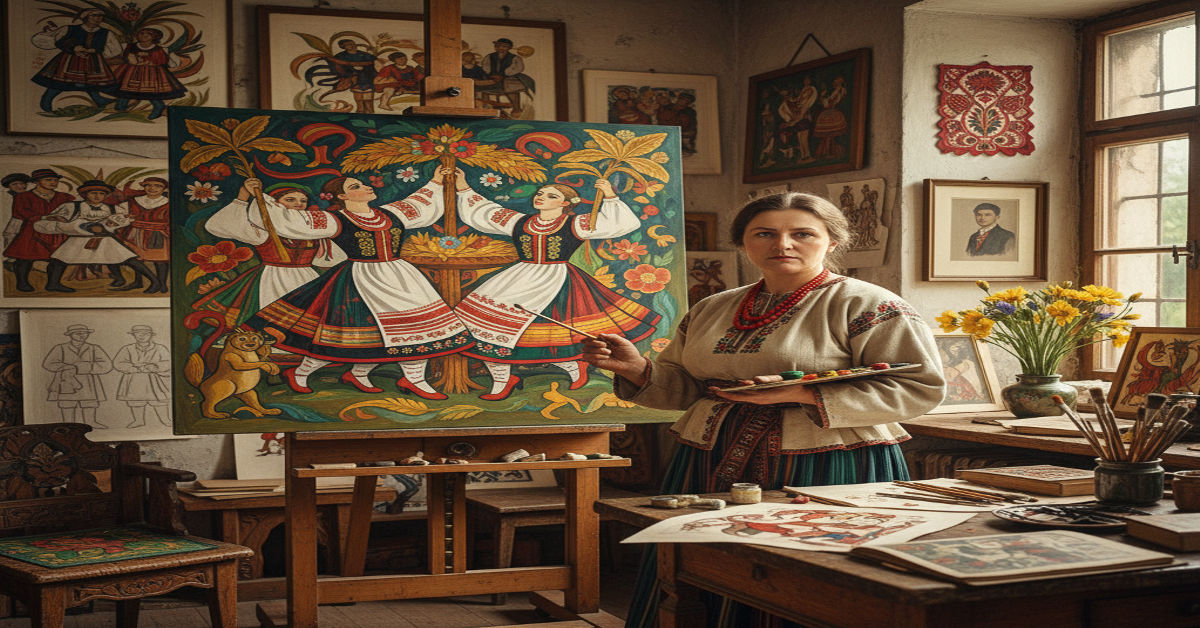Zofia Stryjeńska is not just a name in the annals of art history she embodies the spirit and cultural heritage of Poland. A pioneering female artist her vibrant works pulse with life, showcasing an intricate blend of tradition and modernity. Born in a time when women often struggled for recognition, Stryjeńska carved out her own space in the male-dominated world of painting. Her canvases resonate with stories that reflect both personal introspection and national identity. As we delve into her world, we’ll uncover how this remarkable woman painted more than just pictures—she painted her nation’s soul.
Early Life and Career
Zofia Stryjeńska was born in 1891 in Kraków, a city steeped in Polish culture and tradition. Her family played an essential role in shaping her artistic journey. Raised by parents who appreciated the arts, Zofia found encouragement to explore her creative talents from an early age.
She studied at the Academy of Fine Arts in Kraków, where she honed her skills and developed a unique style that would set her apart. Stryjeńska’s dedication led her to travel across Europe, absorbing influences from various art movements. Yet, it was Poland’s folk traditions that resonated deeply with her spirit.
Her career took off when she began showcasing works that celebrated Polish folklore and identity. These pieces captured not only picturesque scenes but also the essence of what it meant to be Polish during turbulent times. Each brushstroke reflected both personal passion and national pride as Zofia carved out her place within the art world.
Influence of Traditional Polish Art on Her Work
Zofia Stryjeńska’s artistry is deeply rooted in the rich tapestry of traditional Polish art. She drew inspiration from folk motifs, integrating them into her unique style.
Her vibrant palettes and intricate designs reflect the essence of Slavic culture. The patterns she employed often echoed those found in regional textiles and ceramics, bridging modernity with heritage.
Stryjeńska did not merely replicate these influences; she transformed them. Her works radiate a sense of pride and nostalgia for Poland’s cultural identity. Each brushstroke tells a story, connecting viewers to their roots.
Moreover, her use of symbolism adds layers to her pieces. Elements like flowers, animals, and mythical figures resonate with historical significance.
This fusion of tradition and innovation makes Stryjeńska’s work timeless. It allows her paintings to serve as both artistic expressions and cultural commentaries on Poland’s ever-evolving narrative.
Themes and Symbolism in Stryjeńska’s Art
Zofia Stryjeńska’s art bursts with vibrant themes that reflect the essence of Polish culture. Folk traditions permeate her work, showcasing rural life and seasonal celebrations. Each canvas serves as a window into the spirit of Poland.
Symbolism plays a significant role in her pieces. She often incorporates elements from Slavic mythology, weaving tales that echo ancient legends. Her figures are not just subjects; they embody stories and emotions deeply rooted in national identity.
Color is another powerful tool for Stryjeńska. Bold hues convey joy, sorrow, or nostalgia, evoking strong reactions from viewers. Patterns drawn from folk costumes create a tapestry of cultural pride.
Nature also finds its way into her works—forests, rivers, and mountains signify both beauty and resilience. Through these themes and symbols, she crafts a narrative that resonates across generations while celebrating the uniqueness of Poland’s heritage.
Controversies Surrounding Her Art and Personal Life
Zofia Stryjeńska’s life was as vibrant and complex as her art. Raised in a traditional Polish family, she often faced scrutiny for her bold approach to cultural themes. Her work challenged societal norms, which drew both admiration and criticism.
In the 1930s, Stryjeńska embraced modernism while incorporating folklore elements. This fusion sparked debates about authenticity in Polish art. Some traditionalists viewed her style as a departure from genuine heritage.
Her personal life added another layer of intrigue. As an independent woman artist during a tumultuous time, she navigated gender expectations that often limited female creators. Marriage and motherhood further complicated her career trajectory.
Despite the controversies surrounding her choices and artistic vision, Stryjeńska remained unapologetically herself. Her willingness to confront conventional boundaries made her a polarizing yet influential figure in Poland’s cultural landscape.
Legacy and Impact on Polish Art
Zofia Stryjeńska’s impact on Polish art is monumental. Her bold use of color and traditional motifs revitalized the national artistic scene in the early 20th century.
Stryjeńska’s work resonates with a sense of identity, drawing from folklore and Slavic mythology. She captured the essence of her culture in ways that continue to inspire contemporary artists.
Many view her as a pioneer for women in art, breaking barriers during an era when female voices were often sidelined. Her strong presence encourages new generations to explore their roots more deeply.
Even today, exhibitions celebrate her contributions, ensuring that her vibrant interpretations remain relevant. The themes she explored—identity, tradition, and femininity—still evoke powerful conversations about heritage and modernity in Poland.
Her distinctive style has left an indelible mark on the cultural landscape, solidifying Zofia Stryjeńska’s place as a key figure in Polish artistry.
Conclusion: Remembering the Soulful Art of Zofia Stryjeńska
Zofia Stryjeńska crafted a unique narrative through her art, intertwining the essence of Polish culture with vibrant colors and bold motifs. Her work transcended mere aesthetics it told stories that resonated deeply within the hearts of her people. Today, as we reflect on her creations, we find ourselves not just looking at paintings but feeling the pulse of a nation’s soul.
Her legacy continues to inspire new generations of artists in Poland and beyond. The themes she explored remain relevant, embodying resilience, identity, and tradition. Stryjeńska’s ability to blend folklore with contemporary artistry creates an enduring link between past and present.
As we appreciate her contributions to Polish art history, it’s clear that Zofia Stryjeńska was more than just an artist—she was a cultural icon who captured the spirit of her time. Her work invites us all to connect with our roots while envisioning future possibilities. In remembering Zofia Stryjeńska, we celebrate not only her exceptional talent but also the rich tapestry of Polish heritage she represented so beautifully through brushstrokes and vibrant palettes.







